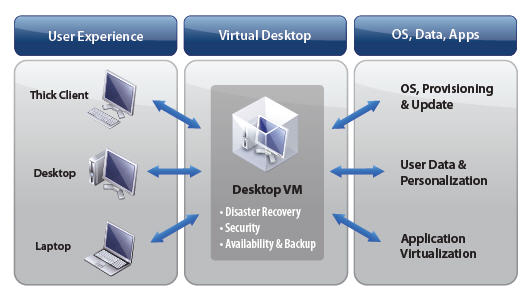VMware: Desktop virtualization tipping point in 2011?

Information technology folks have heard it all before---the desktop will be thin; PCs will be virtualized; there will be centralized control of multiple computing devices. That chatter has been going on for more than a decade to no avail.
Is this time different?
Tod Nielsen, chief operating officer of VMware, thinks so, but he's not going to be screaming from the rooftops about virtualized desktops. Why? Many executives have talked that game and we're still waiting for there thin, virtualized clients to become the norm.
Nielsen had a nice summary on the state of desktop virtualization on VMware's earnings conference call:
We continue to hold high expectations for the desktop virtualization market, yet it remains difficult to predict at what pace customer interest and evaluations will turn into accelerated buying. We are seeing Windows 7 upgrades and the proliferation of new end-user devices such as the iPad and smart phones, are fueling public discussion and customer interest. However, no single technical or economic tipping point is emerging as the accelerant to Virtual Desktop Infrastructure adoption.
What is emerging is a trend where IT executives are exploring much broader architectural implications of managing users in dramatically different ways. Many customers are not looking at a traditional product feature cost/benefit analysis, but rather asking larger questions about how they're going to manage users in a dramatically changing world defined by mobility, ubiquitous computing and increasing end-user demand and expectations. We believe this bodes well for VMware as we further position our desktop strategy within the context of these broader requirements and architectural changes.
VMware CEO Paul Maritz echoed VMware's desktop virtualization plans. Executives also talked about a new version of View, which would enhance the company's desktop virtualization plans. VMware View is software that's aimed at virtualizing the desktop upgrade cycle.
Maritz said:
At the end-user or desktop level, we seek to build upon the current model of desktop virtualization and speak to the need of enterprises to focus more on managing users and spend less time managing devices, particularly in a world where endpoint devices are becoming increasingly heterogeneous. We'll be providing a path to our customers whereby they can move forward in an evolutionary way from their current Windows-centric environments and, in this context we are looking forward to the release of 4.5.
One analyst on the call noted that 2011 could be the year of desktop virtualization.
Nielsen said:
As I think we said in the past calls, there's a strong interest in VDI, desktop virtualization, in general. We've, in some quarters, had as much as 60% of our proof-of-concept resource focused on desktop and desktop virtualization. With Windows 7 and those sort of rollouts and upgrades on the horizon, there's definitely a strong interest, as many customers are saying, if they're going to make the upgrade to Windows 7, they're going to make a transformative change, like a desktop virtualization effort as well. So I'm a little bit cautious to declare 2011 the year of the desktop since for the last few years it's been declared the year of the desktop, but we're optimistic on the opportunity.
My take: The time for desktop virtualization on an enterprise scale will be right at some point. It just makes too much sense. Meanwhile, we've heard from a few CIOs who have been pondering using virtualization to deploy Windows 7. Those efforts remain mostly on the whiteboard though. But if you're going to upgrade to Windows 7 you might as well go for a bigger bang. Nielsen's cautious optimism approach about desktop virtualization also makes a lot of sense. The rub: If Windows 7 doesn't spur desktop virtualization it could be another six years before it's on the table again. Those desktop upgrade cycles are only getting longer.
